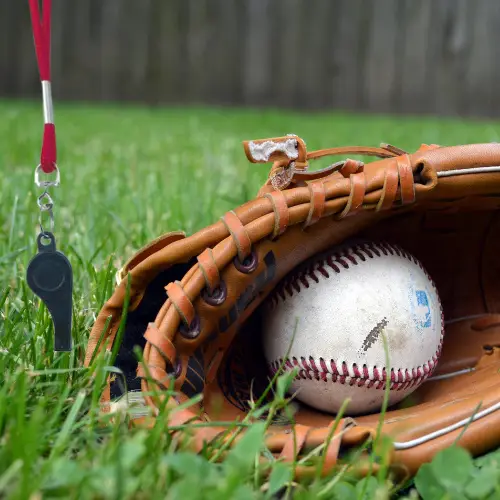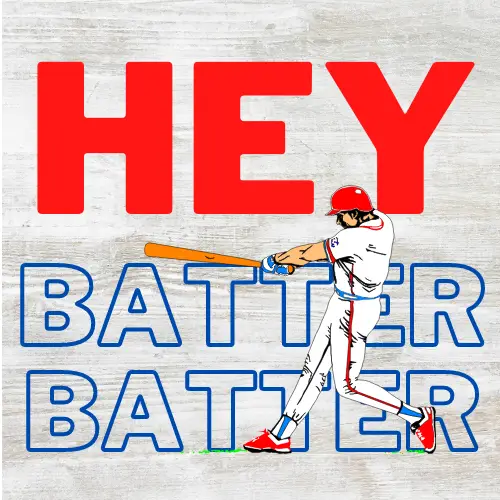
If talk of baseball has you thinking about buying some peanuts, Cracker Jacks, hot dogs and a beer, I’m with you 100%!! The song resonates with most of us, and a bun in one hand with a brew in the other is simply marvelous on a warm sunny day!
There is more to the game than a great time and the crack of a bat. Maybe you know the basics of hitting and running, but aren’t quite up to par on the rest of the rules.
No worries! I’ll fill you in so you can talk the talk-and-walk-the-walk in baseball when it comes to everything from fly balls to The World Series!

Object: How do you win in baseball?
- Score more points (runs) than the opposing team by the end of the game
- Points are scored when a batter successfully ends up as a runner and touch all 4 bases without getting ‘out’ and without 3 other players getting ‘out’
Duration: How long is a baseball game?
- The average duration of a baseball game is just over 3 hours
- 9 innings
- Timing for each inning varies, depending on when each team gets 3 outs
Players: How many players are on a baseball team?
- 9 players from each team ‘on the field’ at once
- 26 players allowed on each MLB team roster
Teams: How many Major League Baseball teams are there?
- 30 Major League Baseball (MLB) teams
- MLB operates two leagues – American and National
- 15 American League teams
- 15 National League teams
The Baseball Field: How big is a Major League Baseball field?
- Comprised of the infield and the outfield
- The infield is commonly called a diamond – due to the shape made to outline all 4 bases
- This diamond is actually a square with 90 feet on all sides (from one base to the next) so 8,100 square feet
- It is comprised of (counterclockwise) home plate, first base, second base, and third base, then back to home
- If you were to draw a line from home plate to second base, it would be 127 feet, 3 3/8 inches
- 60 feet. 6 inches down that line, you’d find the pitcher’s plate
- The outfield, which is the part of the field after the diamond or infield, is between the extended foul lines, or if you can picture extending the line from home base past first and home base past third – it’s the area in between
- How far it extends to the ending ‘fence’ is different from field to field, but the rule says it must be at a minimum, 325 feet from home plate, so 235 feet past 1st and 3rd and 400 feet from home plate in center field, so roughly another 273 feet past 2nd base

Season: When is the MLB (Major League Baseball) season?
- Starts the end of March or beginning of April
- Ends late September or early October
- 162 games per season
- After the regular season, playoffs follow, with 10 teams – 5 American League and 5 National League (3 division winners and 2 wild cards each) compete
- Each has a League Championship Series culminating in The World Series for the 2 winners
- The World Series is the final 7 games (sometimes less if one team gets 4 wins first) and typically starts at the end of October
Game Play and Scoring: How do you play baseball?
How do you get points in baseball?
Here’s how the game works…
- The game starts off with the home team as defense, on the field, and the visiting team as offense, up to bat.
- The defense has players at each base and in the field
- Also on defense is the pitcher, who throws the ball to the batter, and the catcher, who stands just behind the batter to return balls and plays home plate
- The umpire calls “Play!” and the game is on – I’m remembering “Play ball!” – you?
It’s important to know who the umpire is. He is the enforcer of rules and the ultimate say in whether a batter or runner is safe or out, and if the pitch is a strike or ball.
- The pitcher throws, or pitches the ball to the batter at home plate
- The pitcher wants the batter to swing and miss, getting a strike
- The batter wants to hit the ball and run to at least first base
If he swings and misses the ball, it’s called a strike. He may also fail to swing at a good pitch, also counted as a strike.
If he gets 3 strikes, it’s called an out. There are 3 outs for each team in an inning. There are 9 innings in a game, unless there’s a tie.
The batter may also choose not to swing because he feels the ball isn’t in ‘the strike zone’. The strike zone is the prime hitting area a pitcher can throw the ball to, basically an invisible rectangle from the batter’s shoulders to knees and centered over home plate.
If the batter doesn’t swing and the umpire sees that it’s in the strike zone, it’s a strike. A ball outside of the strike zone that is not swung at is called a ‘ball’.
Four pitches that are outside of the strike zone and not swung at (‘balls’) is called a walk. When a batter walks, it means he goes to first base without having to hit the ball, due to the four ‘balls’.

So now, let’s say the batter does hit the ball…
Wow does he ever! He hits it with such force that it goes beyond the back wall for an ‘out of the park’ homerun. This means that the batter and all baserunners automatically get a run.
If there’s a runner on all 3 bases, this is called a Grand Slam, and four points are awarded, one for each baserunner and one for the batter. A homerun or Grand Slam doesn’t need to be hit out of the park, but is automatic if it is.
If it doesn’t happen to make it all the way past the wall, there are defensive players in the field waiting to catch it. If the batted ball is caught before it hits the ground (usually called a fly ball), it’s an out. If they get the ball and move it to the player on first base before the batter gets there, it’s an out.
Maybe the batter hits the ball, no one catches it in the air and it goes far enough that he makes a successful run to first base. The next batter is up and the process repeats.
There may also be a player that has batted and is on a base. If on first, the player must get to at least second base so the present batter can get to first.
He must also get there before the ball is thrown to the second baseman or he is tagged by a defensive player in possession of the ball. If he fails to do so, he’s out. This applies to all bases and runners.
Again, three strikes and they’re out. Three outs and it’s the other team’s turn at bat.
- The game is over at the end of the 9th inning, as long as the score isn’t tied
- If the score is tied at the end of 9 innings, play continues until the visiting team scores more total runs at the end of an inning, or if the home team scores more at any time in the inning
- Innings continue until there is no tie with the previously stated parameters
Sound confusing? I thought so too. Let me explain a little more.
Since the visiting team starts the game as batters, they have the first chance to score in the game, and are up to bat first in every inning. To make it fair, the home team also needs a chance to score during each inning.
If the game ends in a tie, the visiting team bats first and tries to score as many runs as possible. Upon the third out, it’s the home team’s chance at bat to beat (or tie) that new (or existing) score. If the home team surpasses that score, the game is over and the home team wins, since the visiting team already had their chance.
Here’s an example… Let’s say at the end of the 9th inning, both teams have 10 points (runs). Another inning must now be played. The visiting team is up to bat first and they manage to get 2 more runs before their 3 outs.
It’s now the home team’s turn at bat:
- If they get 0 or 1 run before their 3 outs, the visiting team wins (12 visiting and 10 or 11 home)
- If they get 2 runs before their 3 outs, they tie again and must play another inning
- As soon as they score their 3rd run, the game is over and the home team wins (12 visiting and 13 home)
But wait! There’s more! Adding to the excitement of the game, (and to get closer to home plate) runners do something called stealing a base, or bases.
This happens when a player has already made it safely to a base and they are waiting for the pitcher to throw the ball to the batter or when the catcher is throwing the ball back to the pitcher. They then run to the next base, attempting to get there safely, without an out. Risky indeed!
Speaking of not playing it safe, look at you going out of your comfort zone and learning something new! You know more about baseball today than you did yesterday. Well played!
Now, go watch the game and be confident in your conversations! Keep this article handy as a quick reference and share it with your friends so they can do the same!













